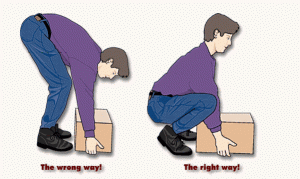Are you a fitness enthusiast or a dedicated athlete who has suddenly been sidelined by a nagging, persistent pain in your calf and ankle? That sharp or aching sensation that flares up during or after activity could be the result of Achilles tendonitis. The Achilles...
We’ve all seen soccer players sidelined by common but painful injuries like ankle sprains, knee ligament tears, and muscle strains. The combination of running, sudden stops, quick cuts, and potential physical contact makes the body, particularly the lower extremities,...
Spinal cord injuries are among the most serious and life-altering injuries a person can sustain. The spinal cord, a complex bundle of nerves, is the primary pathway for communication between the brain and the rest of the body. When it’s damaged, a patient could be...
How to Deal with Back Pain

According to the American Academy of Orthopaedic Surgeons (AAOS), everyone in the world will at some time in their life suffer from some type of back pain. The pain affects each person in different ways. It may come on suddenly and be so debilitating, the person cannot even function. In others, the pain is chronic and miserable, but the person can carefully make it through their daily routine.
The severity of the pain is often unrelated to the severity of the condition causing the pain. There are a few ways you can deal with back pain on your own. In most cases, the pain is relieved within a few weeks. In other situations, depending on your symptoms, you need to seek medical care.
Home Treatments
There are many different causes of back pain and in most cases, with home treatment, it lasts only a few days or weeks.
- If you injured your back, or the pain came on after a sudden move, put ice on the affected area for the first 48 hours. Leave the ice on for only 20 minutes at a time. Heat may feel good at this early stage, but it will cause inflammation and interfere with the healing process.
- Beginning 48 hours after the onset of back pain, give up the ice and switch to intermittent applications of heat. Do not leave the heat on the affected area more than 20 minutes at a time. The heat feels good and it will be tempting to leave it on the area even when you sleep. Do not yield to that temptation. Your skin needs a rest and longer stretches of heat may even increase the pain when the heat is removed.
- Taking over-the-counter (OTC) pain relievers like acetaminophen or aspirin may help.
- OTC anti-inflammatory medications like ibuprofen or naproxen relieve pain while reducing inflammation.
- Resist the temptation to rest. Even though some activities like walking or swimming may be painful, aerobic exercises will help your back heal faster. Avoid exercises that put strain on your back like sit-ups or weight-lifting.
- Pay attention to your posture when standing or sitting. If you work at a desk all day, stand up and stretch every 20 minutes. Sit up straight while working without bending over to see your computer screen.
- Avoid lifting heavy objects. Never bend over to pick up something. Lower yourself with your legs keeping your back straight.
- Women should forego 3 and 4-inch heels and wear flats or shoes with heels that are no more than 1 inch high.
When To Seek Orthopaedic Care
If the home remedies do not relieve the pain within a few days or weeks, or the pain is increasing instead of decreasing, see a doctor. Other indications that you need medical evaluation include:
- The pain radiates down your leg and you have trouble walking.
- Your bladder or bowels are difficult or impossible for you to control.
- The pain is always present and no matter what you do to try and relieve the pain, the pain will not go away.
- The pain is associated with fever or chills.
The pain appears along with unexpected weight loss.


